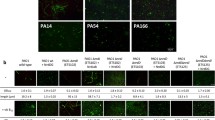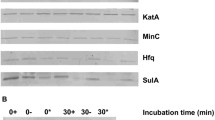Abstract
Pseudomonas aeruginosa is a common opportunistic human pathogen. It generally attacks immunosuppressed patients like AIDS, cancer, cystic fibrosis, etc. The virulence of P. aeruginosa is mediated by various virulence factors. One of such potential virulence factors is HCN synthesized by HCN synthase enzyme, which is encoded by the hcnABC operon. The expressions of the genes of this operon are regulated by three transcriptional regulators, viz., LasR, ANR, and RhlR. In our previous work, we analyzed the molecular details of the functionalities of LasR. In this work, we focused on ANR. ANR is a regulatory protein which belongs to the FNR family and works in anaerobic condition. ANR binds to the promoter DNA, named ANR box, as a dimer. The dimerization of this ANR protein is regulated by Fe4S4, an iron-sulfur cluster. This dimer of ANR (ANR-Fe4S4/ANR-Fe4S4) recognizes and binds the promoter DNA sequence and regulates the transcription of this hcnABC operon. Till date, the biomolecular details of the interactions of ANR dimer with the promoter DNA are not fully understood. Thus, we built the molecular model of ANR-Fe4S4/ANR-Fe4S4. We docked the complex with the corresponding promoter DNA region. We analyzed the mode of interactions with the promoter DNA under different conditions. Thus, we tried to analyze the functionality of the ANR protein during the expressions of the genes of the hcnABC operon. So far, this is the first report to detail the molecular mechanism of the gene expression in P. aeruginosa.






Similar content being viewed by others
References
Lederberg, J. et al. (2000). Pseudomonas. Encyclopedia of microbiology (2nd Edn, vol 3, pp. 876–891). San Diego.
Bodey, G. P., et al. (1983). Infections caused by Pseudomonas aeruginosa. Reviews of Infectious Diseases, 5(2), 279–313.
Van Delden, C., & Iglewski, B. H. (1998). Cell-to-cell signaling and Pseudomonas aeruginosa infections. Emerging Infectious Diseases, 4(4), 551–560.
Solomonson, L. P. (1981). Cyanide as a metabolic inhibitor. In C. J. Knowles et al. (Eds.), Cyanide compounds in biology (pp. 11–28). London: Academic Press.
Gallagher, L. A., & Manoil, C. (2001). Pseudomonas aeruginosa PAO1 kills Caenorhabditis elegans by cyanide poisoning. Journal of Bacteriology, 183(21), 6207–6214.
Pessi, G., & Haas, D. (2000). Transcriptional control of the hydrogen cyanide biosynthetic genes hcnABC by the anaerobic regulator ANR and the quorum-sensing regulators LasR and RhlR in Pseudomonas aeruginosa. Journal of Bacteriology, 182(24), 6940–6949.
Chowdhury, N., & Bagchi, A. (2016). Molecular insight into the activity of LasR protein from Pseudomonas aeruginosa in the regulation of virulence gene expression by this organism. Gene, 580(1), 80–87.
Moore, L. J., & Kiley, P. J. (2001). Characterization of the dimerization domain in the FNR transcription factor. Journal of Biological Chemistry, 276(49), 45744–45750.
Volbeda, A., et al. (2015). The crystal structure of the global anaerobic transcriptional regulator FNR explains its extremely fine-tuned monomer-dimer equilibrium. Science Advances, 1(11), e1501086.
Moreira, I. S., Fernandes, P. A., & Ramos, M. J. (2007). Computational alanine scanning mutagenesis—an improved methodological approach. Journal of Computational Chemistry, 28(3), 644–654.
Bairoch, A. et al. (2005). The Universal Protein Resource (UniProt). Nucleic Acids Research, 33 (DATABASE ISS.).
Altschul, S. F., et al. (1990). Basic local alignment search tool. Journal of Molecular Biology, 215(3), 403–410.
Berman, H. M., et al. (2000). The protein data bank. Nucleic Acids Research, 28(1), 235–242.
Sali, A., (2008), MODELLER a program for protein structure modeling release 9v4, r6262. Structure, (September), pp. 779–815.
Laskowski, R. A., et al. (1993). PROCHECK: a program to check the stereochemical quality of protein structures. Journal of Applied Crystallography, 26(2), 283–291.
Eisenberg, D., Lüthy, R., & Bowie, J. U. (1997). VERIFY3D: assessment of protein models with three-dimensional profiles. Methods in Enzymology, 277, 396–406.
Wiederstein, M., & Sippl, M. J. (2007). ProSA-web: interactive web service for the recognition of errors in three-dimensional structures of proteins. Nucleic Acids Research, 35(SUPPL.2), W407–W410.
Brooks, B. R., et al. (1983). CHARMM: a program for macromolecular energy, minimization, and dynamics calculations. Journal of Computational Chemistry, 4(2), 187–217.
Dauber-Osguthorpe, P., et al. (1988). Structure and energetics of ligand binding to proteins: Escherichia coli dihydrofolate reductase-trimethoprim, a drug-receptor system. Proteins, 4(1), 31–47.
Pierce, B.G. et al. (2014) ZDOCK server: interactive docking prediction of protein–protein complexes and symmetric multimers. Bioinformatics, p.btu097.
Carterson, A. J., et al. (2004). The transcriptional regulator AlgR controls cyanide production in Pseudomonas aeruginosa. Journal of Bacteriology, 186(20), 6837–6844.
Schneidman-Duhovny, D., et al. (2005). PatchDock and SymmDock: servers for rigid and symmetric docking. Nucleic Acids Research, 33(SUPPL. 2), W363–W367.
Kabsch, W., & Sander, C. (1983). Dictionary of protein secondary structure: pattern recognition of hydrogen-bonded and geometrical features. Biopolymers, 22(12), 2577–2637.
Acknowledgements
The authors would like to thank the anonymous reviewers for their constructive comments for the betterment of the manuscript. The authors are grateful to the BIF Center, University of Kalyani, for providing the necessary equipment and workstation to carry out the experiments. The authors would like to thank the Department of Biotechnology (DBT, India) for the financial support (SAN No. 102/IFD/ SAN/1824/2015-2016). The infrastructural support from University of Kalyani is also duly acknowledged here. NC would like to acknowledge the UGC, India, for providing the Rajib Gandhi National Fellowship.
Author information
Authors and Affiliations
Corresponding author
Ethics declarations
Conflict of Interest
The authors declare that they have no conflict of interest.
Additional information
Highlights
• Regulations of hcn operon
• Molecular modeling of ANR protein
• Docking of ANR-Fe4S4/ANR-Fe4S4 with promoter DNA
• Molecular mechanism of gene expression
Electronic supplementary material
Supplementary Figure 1
(JPEG 1656 kb)
Supplementary Figure 2
(JPEG 828 kb)
Supplementary Figure 3
(JPEG 687 kb)
Supplementary Figure 4
(JPEG 713 kb)
Supplementary Figure 5
(JPEG 568 kb)
Supplementary Figure 6
(JPEG 610 kb)
Supplementary Figure 7
(JPEG 672 kb)
Supplementary Figure 8
(JPEG 659 kb)
Supplementary Figure 9
(JPEG 859 kb)
Rights and permissions
About this article
Cite this article
Chowdhury, N., Bagchi, A. Structural Insight into the Gene Expression Profiling of the hcn Operon in Pseudomonas aeruginosa . Appl Biochem Biotechnol 182, 1144–1157 (2017). https://doi.org/10.1007/s12010-016-2388-x
Received:
Accepted:
Published:
Issue Date:
DOI: https://doi.org/10.1007/s12010-016-2388-x




